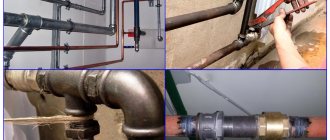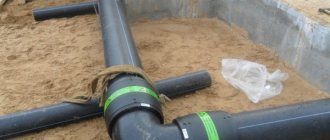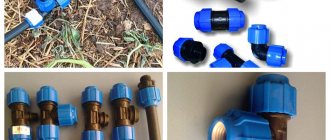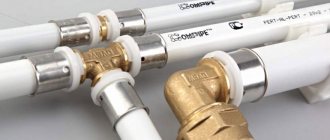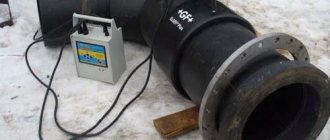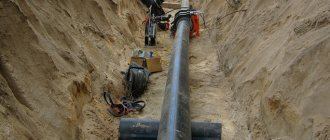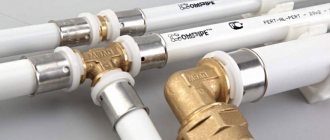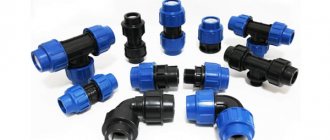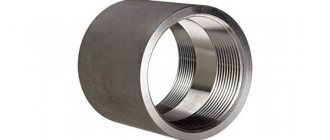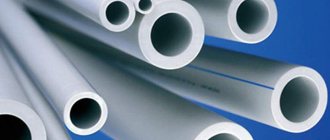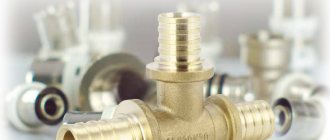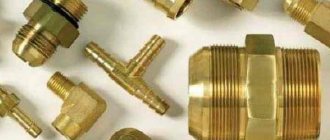Pipes are gradually but confidently squeezing out their competitors - metal-plastic and metal pipes - from the consumer market, and this is happening due to the greater number of their advantages in technical and operational terms. Such areas of the construction and repair sector as heating, plumbing, sewerage and ventilation are switching to PP products, and at the same time they are in increasing demand for the creation of a single functional structure from PP pipes.
The first reason for the demand for propylene is the low cost of production and, as a consequence, the low wholesale and retail cost of products - both pipes and connectors. The second advantage is simple, quick and reliable installation of polypropylene pipelines, the third advantage is the high durability of the products, reaching 50 years or more.
Fittings are produced from polypropylene in accordance with the requirements of GOST-52135, which regulates the scope of their application:
- In hot water supply, where the coolant temperature does not exceed 700;
- In “warm floor” systems, where the coolant temperature does not exceed 60-650;
- In heating circuits with high working fluid temperatures - ≥ 900;
- In cold water and sewer lines of small sizes and volumes.
Pipes and fittings for polypropylene pipes are made from three component options:
- PPR - random copolymer according to SP 40-101-96, trade name - PPRC);
- PPG (polypropylene homopolymer according to GOST 26996-86, trade name PP HO);
- PPV (block copolymer according to GOST R 52056-2003, trade name PP block-copolymer, PP impact copolymer, PPM, PPR, PPU, etc.).
The main difference in the scope of application is different temperature resistance: some types of connecting parts made of PPG cannot be used in heating at high coolant temperatures.
Often, PP connections for polypropylene pipes are designated by the abbreviation MRS, which means the minimum long-term strength of the composite, and determines the operating fluid pressure in the line at which the PP fittings are guaranteed to operate for at least 50 years. The service life of fittings for polypropylene pipes is displayed on the marking as a number after the product material: for example, PPR-60 (nominal pressure 6 MPa), PPR-70, PPR-120. High strength PPRC fittings for PP pipes are capable of working under pressure ≤ 25MPa.
Abroad, polypropylene pipes and fittings are marked with Latin symbols and numbers:
- PP HO (PP) - pure polypropylene without impurities;
- PP-X (PP-XMOD) - cross-linked PP;
- PPCP (PP Co) – copolymer and its component.
There are also many combinations to designate mixed types of polymers.
What are fittings and what are they for?
This term (from the English fit - assemble, adjust) refers to the connecting elements of the pipeline . They are designed for joining pipes of the same or different diameters, forming corners, contours, and branches.
Using fittings, you can shut off the system and also quickly dismantle it if necessary. Regardless of the complexity of the project, it is these elements that make it easy and quick to create the desired structure.
Note! Threaded or compression fittings are not suitable for polypropylene pipes. Only welding can provide the required tightness.
Subtleties of installing a crimp coupling
In a situation where the thread on a pipe has rotted and cutting it is impractical, a universal solution would be to install a crimp coupling.
Installing a crimp coupling is a win-win option in situations where you need to join pipes or connect equipment without involving threads
To correctly install the compression fitting, installation is performed in the following order:
- The pipe section to be joined is cleaned of burrs, treating both the outer and inner surfaces of the product.
- The end of the pipe is inserted into the fitting body, positioning it in such a way that the central part of the coupling strictly corresponds to the joint.
- A crimp ring is pulled onto the pipe.
- A crimp nut is placed on the resulting segment. As the nut moves along the thread, it will press the ferrule into the pipe, creating a tight connection.
When tightening the nut, do not use excessive force. Otherwise, the nut will compress the connection or simply burst.
Types of fittings and size range
Since there are several types of pipe connections, there are several types of connecting elements. Main types:
- A coupling is a simple hollow cylinder used to join two pieces of pipe of the same diameter.
- An adapter is an element designed for the same purposes as a coupling, but allows you to connect pipes of different diameters. They are also used to transition from polypropylene to metal (in this case there is an internal thread at one end).
- Corners for forming a right angle or 45⁰. Despite the relative plasticity of the material and the ability to bend the pipe after heating, this should not be done. On the outside of the bend, the polypropylene will become thinner, which will negatively affect the strength of the entire structure. In this case, folds are formed on the inside, impairing the throughput.
- Tees and crosses are wiring elements used to create several branches from the main line. There are a lot of options for such fittings. Some allow you to remove the pipe at a right angle, others - at a smaller angle. If there is a thread, shut-off valves can be installed on such connections.
- Bypass curved elements are designed for laying complex communications when it is necessary to bypass one or more pipes.
- Shut-off fittings, which are valves and taps, can be either threaded or unthreaded.
- Plugs (also welded or threaded) are a necessary element for completing a pipeline line.
- “American” is a special type of fitting in the form of a coupling with a union nut, used in cases where the structure needs to be periodically disassembled.
We recommend that you read: Types of steel fittings and features of their installation
It is important! The selection of connecting elements is carried out in accordance with the outer diameter of polypropylene pipes. In this case, it is advisable to purchase products from the same manufacturer.
The size range is presented in several options. For domestic needs, as a rule, fittings of 16, 20, 25, 40 mm are used (this size corresponds to the outer diameter of the pipes used).
The maximum size for household pipelines is 50 mm, and for industrial ones polypropylene pipes of a larger cross-section are produced. At the same time, different technologies and elements are used to connect them.
Advantages and disadvantages of PPR pipes
A variety of fittings make it quite easy to assemble any pipeline that can work with almost any environment, since the material is chemically neutral. Everything is connected together using a welding machine, you can master the welding technique in a few tens of minutes - everything is simple and accessible
It is very important that polypropylene is not afraid of defrosting - when it freezes, it expands slightly, and when thawed, it returns to its size. It can withstand light loads quite well, but for long-term operation, it is better to protect the pipeline from mechanical stress and ultraviolet radiation (it becomes fragile when exposed to direct sunlight for a long time)
The inner surface of the pipes is nasty, deposits and sediments do not accumulate on it, so normal permeability is maintained for many years, which allows you to use pipes of smaller diameter and pay less for them. It is also important that the cost of such a pipeline is lower than a similar metal-plastic one.
Glass fiber reinforced polypropylene pipes and fittings for them
There are two serious shortcomings. First: large thermal expansion (5 cm per 1 meter of pipe), so to level out changes in linear dimensions, compensators (of any shape) are required. The second is high oxygen permeability. For water supply systems this is not very bad, but for normal operation of the heating system it is advisable to take pipes with solid aluminum reinforcement, which have an almost 75% lower coefficient of thermal expansion and significantly reduce oxygen conductivity, and can withstand high temperatures quite well (up to 95° WITH).
Classification of fittings
Based on the composition of the material, all polypropylene fittings are divided into 3 main categories, the difference between which lies in their temperature resistance:
- homopolymer (HPP) – not used for heating systems;
- random copolymer (RPR);
- block copolymer (PPV).
The last two varieties are resistant to high temperatures. Another parameter, designated by the MRS nomenclature, characterizes the minimum duration of strength. It indicates the maximum permissible pressure in the pipeline, at which an operational life of 50 years is guaranteed. For example, the PPR-80 marking indicates a product made of random copolymer that can withstand a pressure of 8 MPa.
According to their intended purpose, there are 4 options for using polypropylene pipes and connecting elements (GOST No. 52135):
- pipelines for transporting cold water;
- low-temperature underfloor heating communications (maximum - 60⁰С);
- pipeline for hot water supply (not higher than 70⁰С);
- radiator-type heating systems (up to 90⁰С).
Properly selected pipes and connecting fittings will ensure strength and durability of communications.
Welded polypropylene solder fittings
Fittings for welding joint must be suitable for PPT material. These elements are bell-shaped, that is, they are put on the end of the pipe. At the same time, they can be connected in this way only after heating both parts: if the pipe is inserted into the fitting in a cold state, then the latter is not suitable for installing the pipeline.
Note! Another parameter of connecting fittings that affects its reliability is the production method. Cast fittings, unlike segment ones, are characterized by increased strength (but are more expensive).
When purchasing pipes and components, it is advisable to give preference to European manufacturers. There are various brands on the market today, including many Chinese ones. The latter are more attractive in cost, but their quality and durability in most cases are difficult to guarantee.
We recommend that you read: How do plastic air ducts work in ventilation systems?
Types of PP pipes
According to their design characteristics, PP pipes are divided into two types:
- solid;
- reinforced
Both types have a set of both positive and negative characteristics.
Pros and cons of solid products
One-piece long products marked PPR are lightweight, durable and relatively inexpensive. The pipeline made from them easily tolerates freezing and thawing without changing the structure.
At the same time, a significant disadvantage is the low melting temperature threshold inherent in thermoplastics - 175⁰. The beginning of softening occurs already at 135⁰.
Even if the water temperature in the system is stable and does not exceed 95⁰, but the pressure is high, the combination of these two factors can lead to a gradual decrease in the integrity of the material.
Polypropylene is deformed lengthwise when exposed to heat. If such a pipe is placed in a floor screed or wall without taking into account the change in length, due to stretching and the appearance of waves on the surface of the pipes, the material under which they are located will begin to crack
The obvious conclusion is that it is better not to use solid PP pipes for transporting very hot water. They are quite suitable for installing a water supply system with drinking or industrial cold water. Polypropylene does not affect the composition of water.
A special place in the category of solid PP pipes is occupied by modified polypropylene labeled PPs - the highest quality material. It is polyvinyl sulfide with a unique molecular structure. The diameter of PPs pipes is from 20 mm to 120 cm. They are universally used.
Reinforced PP pipes
Reinforced pipes differ from solid pipes in having a lower coefficient of thermal expansion. The reinforcing frame included in the pipes is made of fiberglass or aluminum foil.
Fiberglass frame is a more modern option. The advantage is simplified welding, since there is no need to strip the ends of the reinforcing layer and calibrate. Since the frame is soldered into the body of the product, there is no such phenomenon as delamination. The linear expansion coefficient is 6%.
Aluminum reinforcement can be continuous, when during the production of pipes an aluminum strip is inserted into their body, or perforated. The second option is to replace the tape with a mesh with small holes.
Reinforcement with perforated aluminum foil ensures the creation of a single monolith due to the strong connection of all layers. This surface is resistant to delamination
PP pipe reinforced with strip aluminum foil tolerates high temperatures well. Actually, this is already a full-fledged metal-plastic pipe. Such pipes are connected along the inner layer. Before this, the outer shell and the reinforcing layer are removed.
The characteristic differences between metal-plastic and polypropylene pipes will be introduced in an article devoted to the analysis of the properties and assessment of the qualities of both varieties.
In cold regions, even the highest quality polypropylene pipes are not recommended for centralized hot water supply and heating. It is better not to expose plastic communications to significant temperature changes.
The procedure for welding polypropylene pipes with fittings
Self-installation of a household polypropylene pipeline if you have the necessary equipment and high-quality components is not difficult. To do this, you will need a special soldering iron with suitable nozzles for pipes and fittings. The operating procedure is as follows:
- Using a roller pipe cutter, cut a piece of pipe of the required size strictly perpendicularly.
- Clean the cut with sandpaper (you can also degrease it).
- Attach the necessary attachments to the soldering iron and heat it to a temperature of about 260⁰C.
- Place a fitting and a piece of pipe onto the heated device, wait the prescribed time (it depends on the diameter and ranges from 3 to 10 minutes).
- Remove the parts and insert the pipe into the fitting to the maximum depth (all the way), without rotating.
Then you need to leave the compound until it hardens completely at room temperature. Sagging from it, as well as polypropylene residues from the nozzles, are removed with a rag.
Compression and press fittings
These types of connecting elements are used more often for reinforced pipes made of PP and are made of brass (body). Each of them has features of installation and operation, and the advantage of both over a welded connection is the absence of sagging inside the pipe, which reduces the throughput of the system.
Compression
The element consists of a brass body, O-rings, a fitting and a ferrule nut. The tightness of the joint is ensured by squeezing the sealing material when crimping the pipe.
The tools you will need are regular open-end wrenches or an adjustable wrench. This type of connection can withstand a pressure of 35 bar and is designed for a service life of 30 years; the nuts will need to be tightened periodically.
Press
They consist of a body and a fitting with a crimp sleeve. This design provides the most airtight connection, however, special pliers are required for operation.
The cost of this tool varies between 3-10 thousand rubles. Since the pressure withstand and service life of press fittings are higher (75 bar and 50 years, respectively), the pipeline can be located inside monolithic structures.
We recommend that you read: How to clean rust from a metal pipe
Drip Irrigation Fittings
The connecting fittings used in the construction of drip irrigation systems are called start connectors. They are intended for connecting drip tapes - branches from the main line. The feed pipe of the start connector has a standard 16 mm diameter. Installation is performed as follows:
- A hole is made in the main pipe using a regular or special 17 mm drill.
- First, the seal supplied with the connector is inserted into it, and then the fitting itself.
- The drip tape is attached to the fitting and then secured with a crimp nut.
There are several types of start connectors: there are crosses and tees for discharging several tapes, couplings for repairs, as well as fittings with taps that regulate the water supply to the tape.
Design differences
Fittings for polypropylene pipes are used as standard - when mating at turns (corner or tees), at branches and transitions to another pipe size (fitting and coupling). The direct connection of the fitting to the pipe is done by soldering - a special soldering iron and tools are used for this. Melting point – 2600C. If the fitting is used with metal shut-off valves, it is called combined.
Small sizes of fittings are irrational to use, since the thickness of the walls of the mains is much greater: diameters of PP pipes ≥ 110 mm are rarely used in individual communications, therefore, types of fittings for them are not produced. The popular sizes of connecting parts for polypropylene pipes are from 20 to 40 mm.
By design, fittings for water supply and/or plumbing are produced in the form of adapters, coupling products, angles and American ones. Also, a PP fitting can act as a tee when branching a route, and work as a manifold, cross and bypass unit. The material of the joint must match the material of the pipe route, but the American one is an exception to this rule - it is used as a threaded part, so the connected units can be made of different materials.
- Depending on the location and method of application, sewer, heating or plumbing fittings are straight, Y-shaped and T-shaped;
- According to the method of fastening, products are divided into crimp (compression fittings) and welded.
Crimped joints have the following advantages over welded ones:
- Simple, reliable and quick installation without special professional training and complex equipment;
- Work in any technological and weather conditions (temperature and pressure changes, sub-zero temperatures).
- A threadless coupling connection is the simplest type of device used to connect polypropylene pipes and fittings. Visually, the coupling looks like a PP cylinder, the outer diameter of which should be the same as the outer diameter of the pipes. Scope of application of coupling joints: heating circuits, hot water and hot water supply, installation of pipelines and pneumatic mains. The coupling can be used to connect metal and PP pipes into a socket, followed by soldering or welding. In addition to the coupling joint, welded or brazed fittings are used, such as corner bends, adapters for different diameters and materials, tees for branching the line, and manifolds for multiplexer units;
- Tees are cut into the places of branches and branches of communication; such fittings for polypropylene pipes can withstand a liquid temperature of ≤ 950C and a maximum pressure of ≤ 2.5 MPa. Insertion into polypropylene pipes can be done with a transition to a different diameter;
- Manifold fittings are used in heating systems, and their main function is to tightly connect the circuit to the heat generator. Ball shut-off valves can be built into the collector circuit.
- Angle fittings change the direction of the line by 900 in liquid pipelines. Connected by welding or soldering.
Features of installation of fittings
Working with welded, compression or press fittings does not require special qualifications or experience. If you have a well-designed communications plan and the necessary tools (soldering iron, scissors, keys, etc.), installation will not cause any difficulties. But it is necessary to take into account some features:
- For welding polypropylene pipe sections, connecting elements of their corresponding material without threads are used. And to transfer from the metal part of the pipeline to the PP, you will need fittings that have a thread at one end;
- To install a system for household use with a diameter of fittings and pipes up to 50 mm, a simple low-power soldering iron is sufficient. If you need to install communications of a larger cross-section, you will need a device with centering;
- If there is aluminum pipe reinforcement, it must first be cleaned to the soldering depth using a trimmer or shaver.
All installation work must be carried out at an ambient temperature of at least 5⁰C to prevent subsequent deformation of the connections. Compliance with this and the above requirements will ensure tightness and long service life of the system.
Manufacturers and technical specifications
Italian polypropylene pipes and fittings Valtec (“Valtek”) are produced in three categories: conventional thin-walled, reinforced with fiberglass and foil. At the same time, the manufacturer states that the foil contains 99.4% aluminum. The layers are glued together using adhesives from Japan and the USA, which give a layer strength of 70 N/10 mm at a rate of 15 N/10 mm. The company makes fittings from PP-R 100, which guarantees its durability. There are some design features of Valtec fittings: their sockets are conical in shape, and no bead of molten material is formed during welding. Another nuance: combination fittings (with metal threads) have an octagonal outer shape, which allows you to use standard wrenches when working with them.
Valtec polypropylene pipes and fittings
The German company Banninger Kunststoff-Produkte GmbH also produces pipes and fittings from random copolymer polypropylene. This raw material is chemically neutral and allows the use of pipelines from this company to supply drinking water. It is worth remembering that Germany has adopted the most stringent safety standards for building materials in the European Union. So, if the Germans are ready to use them to supply drinking water, then there is no doubt about their safety. The only drawback of Banninger polypropylene pipes and fittings may be their rather high price.
Banninger polypropylene pipes and fittings
The products of the Czech company Wavin Ecoplastic have an impeccable reputation. This is exactly the “eco-plastic” that is of excellent quality, and not fake. Before purchasing what sellers call “eco-plastic”, check the country of origin of the product. If this is not the Czech Republic, then this is one of the crafts, the quality of which is difficult to vouch for. Why are Ecoplastic polypropylene pipes and fittings so good? Because the manufacturer guarantees that they will withstand 20 atmospheres, and only high-quality materials are used for manufacturing. Ekoplastik Stabi - foil-reinforced pipes, Ekoplastik Fiber and Basalt+ are reinforced with basalt fiber. The rest are unsuitable for hot water supply or heating, but are very good for cold water.
Polypropylene pipes and fittings Wavin Ecoplastic
Polypropylene fittings and Turkish pipes have fairly good reviews on the forums. They have good quality and low prices. Available:
- Simple pipe PN10 and PN16.
- With fiberglass reinforcement (fiber) Kalde PN16.
- Superpipe Kalde - pipes with aluminum reinforcement, but the foil is not solid, but perforated. Therefore, when welding, it does not require stripping or trimming. The manufacturer says that at an ambient temperature of no more than 70°C, the service life of a pipeline made from such elements will be 50 years. For hotter environments the period is reduced.
Naturally, a set of fittings are produced for each type of pipe.
Polypropylene pipes from the Turkish company Kalde with perforated aluminum
Another Turkish manufacturer is Tebo. Polypropylene pipes and fittings of this brand are made from a resistant new polymer Polypropylene Random Copolymer (“Random copolymer” PPR type 3)
This company pays great attention to certification: there are documents of compliance with GOST, DIN and TSE. Product diameters from 20 to 160mm, product types - PN10, PN20, PN25
Solid foil is used for reinforcement, therefore stripping when welding PN25 pipes is required.
Polypropylene pipes and fittings Tebo
There is another Turkish company SPK on the market. Its products are of fairly high quality, and prices for some products are 50% lower than those of European manufacturers. In this case, raw materials are used from Holland, and the equipment at the factories is German. The quality of SPK pipes and fittings is high: they can withstand operation in Siberian conditions, which is a fairly compelling argument in favor of this campaign.
Polypropylene pipes and fittings SPK
These are not all manufacturers, but they are the most frequently used and have decent quality.
Differences from compression analogues
Due to inexperience and ignorance of all the nuances of installing metal-plastic pipes, press fittings can be confused with compression fittings. They also have a fitting and a sleeve. Only the latter is crimped not with a tool, but using the union nut included in the design.
The main difference between these parts is the different type of connection resulting from installation. The compression version can be disassembled if necessary, but this cannot be done with a pressed version. The press fitting can only be cut off from the pipe to be replaced with a new one.
If a leak develops at the connection point, the nut of the compression fitting can be tightened, but the maintenance-free press fitting will have to be completely removed (+)
However, the likelihood of a leak in the press connection is practically zero. It is not for nothing that this installation method is recommended for use when installing heated floors under screed and when embedding pipelines into the wall.
Cases when such fittings begin to leak in concrete occur extremely rarely in the practice of plumbers. This is more of an exception to the rule.
On the other hand, installation of both types of press fittings requires specialized tools. And to tighten the nuts of compression products, you only need a pair of wrenches.
As a result, on one side of the scale there is “expensive tools + higher reliability of the joint”, and on the other “no extra expenses + a slightly higher risk of leaks”. The choice here is only up to the master and the owner of the house where the pipeline is being laid.
Installing flanges
This option is more suitable for those who work with large diameters. Thanks to it, during operation there are fewer problems with access if cleaning is necessary.
The flanges look like flat disks supported on straight bars.
Installation of pipes in the system consists of several stages.
- It all starts with creating an even cut at the ends of the workpieces. The main thing is that there is no dust or shavings inside.
- Then they proceed to putting the flanges on the sections prepared in advance. We place rubber gaskets between the places with the discs.
- Bolts are used to connect flanges to each other. It is important that the tightening is uniform, without applying much force.
It is recommended to separately ensure that the edges of the rubber gaskets do not protrude more than 10 millimeters.
Technology of using press fittings
Connecting copper or XLPE pipes requires the following tools:
- scissors for cutting plastic pipes (steel products are cut using a grinder);
- chamfer;
- calibrator;
- tape measure, marker;
- press jaws for the corresponding fitting profile.
It is rational to use press pliers for connecting small-diameter pipes (up to 26 mm); for crimping large-sized products, an electrically driven tool is required - a press gun, with the use of which crimping a fitting takes no more than 5 seconds. You also cannot do without a press gun if you are working on connecting steel pipelines, the crimping of which requires increased effort.
Installation of cross-linked polyethylene pipes is carried out according to the following algorithm:
- Using a pipe cutter, the pipe is cut at a right angle to its axis (the tightness of the connection directly depends on the accuracy of the cut - the end part of the pipe must fit tightly to the fitting body).
- An internal chamfer is cut on the pipe cut using a chamfer remover. The ovality of the end formed during cutting is removed with a calibrator.
- A fitting crimp sleeve is placed on the pipe, after which the pipe is pushed onto the fitting until it stops.
- Using pliers or a press gun, the sleeve is crimped.
Crimping a press fitting
If the installation is performed correctly, after crimping, pronounced rings form on the sleeve, which indicate the tightness of the connection. Please note that crimping a fitting can only be done once; if the connection is defective, you must cut off the part of the pipe on which the press fitting is attached and repeat the installation using a new product.
Features of selection and review of manufacturers
Press fittings are supplied to the market by a fairly large number of manufacturers; they are represented in the assortment of every company that sells cross-linked polyethylene pipes and metal-plastic products. Having studied consumer reviews and the opinions of specialized experts, we will highlight two companies - Henco and Tiemme.
Henco is a Belgian company, one of the market leaders. The company produces two types of press fittings - Henco PK and Henco PG. The PG series features standard brass products with a protective galvanized coating, while the PK press fittings have a PVDF (polyvinylidene fluoride) polymer body. Fittings from Henco are produced for pipelines made of cross-linked polyethylene with a diameter of 16, 20, 26, 32 and 40 mm.
Brass products can be used in hot water supply and heating systems (temperature maximum +115), while PVDF press fittings are intended for cold water supply pipelines.
Tiemme is an Italian manufacturer whose product range includes press fittings of the following series:
- Tiemme Cobra - a line of fittings for cross-linked polyethylene pipes;
- Tiemme 1650 - press fitting for reinforced metal-plastic pipes;
- Tiemme 2670 – press fittings for metal-plastic pipelines transporting gas.
The Tiemme fitting body is made of brass, the crimp nut is made of stainless steel. The maximum temperature of the products is +95 (short-term temperature +110), they can withstand pressure up to 16 Bar. Diameters – from 15 to 63 mm.
When choosing press fittings, beware of fakes, of which there are quite a lot on the market - pay attention to the weight (brass fittings are massive, low weight indicates that some cheap alloy is being passed off as brass), the thickness of the crimp sleeve and the markings (the letters must be engraved , and not applied with paint). Tools for installing fittings - press pliers - are also presented in the range of these companies
Henco pliers (the set includes attachments for press fittings with a diameter of 16 and 20 mm) will cost you 15 thousand, from Tiemme - 14 thousand rubles. However, the pliers from the Italian company are designed for use with pressing guns, while the tool from Henco is used for manual crimping
Tools for installing fittings - press pliers - are also presented in the range of these companies. Henco pliers (the set includes attachments for press fittings with a diameter of 16 and 20 mm) will cost you 15 thousand, from Tiemme - 14 thousand rubles. However, the pliers from the Italian company are designed for use with pressing guns, while the tool from Henco is used for manual crimping.
How to solder structures?
Polypropylene blanks cannot be joined without a special welding machine, which is called an “iron”. It works when connected to a regular electrical network.
It is better to purchase the materials themselves with a small reserve, in case of possible errors.
The process consists of several stages. This will allow you to understand how to solder a polypropylene pipe.
- Several cuts are made where the joints will be located in the future. Thorough cleaning of the ends is also required. Special marks are made on their surface with a marker. They indicate at what depth the parts inside the heating apparatus should be located. The temperature of the soldering iron should be at least 270 degrees.
- Strictly perpendicular connection of nozzles with a hot soldering iron. The same is done with the ends of other connections.
- Wait 10-15 seconds until melting is complete. Then they get rid of the attachments, and the parts are connected again. They are lightly applied to each other, but turning is unacceptable.
- The parts to be joined must be left in one position for some time until they cool down.
Video: learning how to solder
How NOT to solder polypropylene pipes!
Socket soldering is an option that is used for pipes with a diameter of 40 mm and larger. But it is recommended to trust such work to specialists, only they know about all the features.
It is better to heat the connecting elements from the inside, and the pipes from the outside. Then it will be easier to create nodes that are highly durable. Otherwise, small tubercles form inside, which reduces patency. Blowing out the structure will allow you to forget about such problems.
Types of PVC fittings
Depending on the method of connecting PVC pipes and fittings, fittings can be adhesive, threaded, detachable, intended for soldering, or combined. The first type of fittings is fixed to the pipe using cold welding. PVC elements have sockets into which the ends of the pipes fit with a minimum gap, which are treated with special glue.
Threaded fittings are attached using a nipple equipped with a male thread and a nut. The elements are made of a more rigid polymer, which is characterized by a lower elasticity coefficient. This technical solution provides a high density of threaded connections.
Detachable fittings are mounted using elastic rubber couplings. Such products are not able to withstand high pressure. It is advisable to use them for installing a non-pressure drainage system. Solder fittings provide a reliable and tight connection using a low-temperature apparatus.
PVC fittings come in detachable, adhesive, threaded and combined types.
In combined versions, a pipe is glued on one side of the product, and on the other side a threaded connection is used using a union nut. This option is used in places with increased requirements for tightness and mechanical strength of fasteners.
Depending on the operational characteristics, fittings for PVC pipes are pressure (for water supply systems), non-pressure (for sewers and storm drains) and used for discharged environments. According to their purpose, PVC shaped parts are divided into connecting, branching and regulating.
Polypropylene is considered a universal polymer. Using products made from polypropylene pipes with your own hands using fittings, you can arrange various utility lines. Elements made of HDPE and PVC have some limitations in their scope of application, which is associated with the technical characteristics of the material. To create a reliable and durable system, it is necessary to purchase fittings and pipes from the same material, and an important criterion is the correct choice of method for installing network elements.
Popular makes and models
Banninger brand products
The Germans are considered one of the most popular manufacturers of fittings. These include companies:
- Banninger - pipes and connections made from environmentally friendly materials that do not change the taste of water and its chemical properties. All products have the necessary strength and lightness, do not rust or become clogged during operation, do not transmit vibration and do not break when frozen.
- Aquatherm – German quality and full compliance with certificates. The connections of this company have a wide range of applications; they can be used in heating, any water supply and even in shipbuilding.
- Wefatherm - pipes and connections fully satisfy all the requirements for pipelines for a wide variety of purposes. This company produces products from new generation materials, for example, glass fiber reinforced polypropylene. Such pipes and fittings have minimal thermal expansion; no stripping is required during assembly (reduces installation costs).
- Ecoplastic is a Czech company that sets a quality standard. Its products are not inferior to German ones, and prices are much lower. The declared service life of pipes and fittings is 50 years.
- TEVO, a Turkish manufacturer of polypropylene products, has been competing in the market with the Czechs and even the Germans for several years. Large range of pipes and connections for them.
- BLUE OCEAN and Dyzain are Chinese in the polypropylene products market. In general, the quality of manufacturers from this country is not very high, but these two have proven themselves well. Their products have the necessary characteristics. A special advantage is the low cost. Among the disadvantages, there are some difficulties during installation.
- PRO AQUA, RBK, Santrade, Heisskraft, Polytek are domestic manufacturers of polypropylene products, the quality of which is not inferior to foreign ones. The main advantage of Russian companies is that only their products can withstand a pressure of 70 atm; accordingly, they will have the longest service life.
